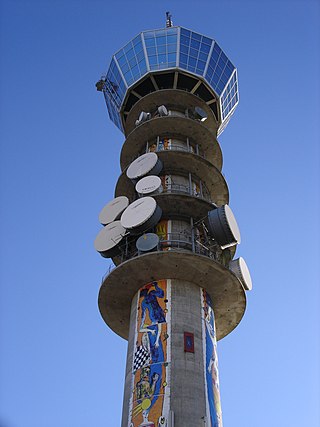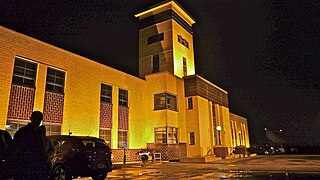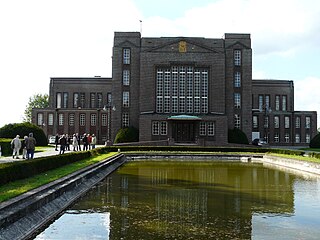Related Research Articles
International broadcasting consists of radio and television transmissions that purposefully cross international boundaries, often with then intent of allowing expatriates to remain in touch with their countries of origin as well as educate, inform, and influence residents of foreign countries. Content can range from overt propaganda and counterpropaganda to cultural content to news reports that reflect the point of view and concerns of the originating country or that seek to provide alternative information to that otherwise available as well as promote tourism and trade. In the first half of the twentieth century, international broadcasting was used by colonial empires as a means of connecting colonies with the metropole. When operated by governments or entities close to a government, international broadcasting can be a form of soft power. Less frequently, international broadcasting has been undertaken for commercial purposes by private broadcasters.

AM broadcasting is radio broadcasting using amplitude modulation (AM) transmissions. It was the first method developed for making audio radio transmissions, and is still used worldwide, primarily for medium wave transmissions, but also on the longwave and shortwave radio bands.

Radio broadcasting is the broadcasting of audio (sound), sometimes with related metadata, by radio waves to radio receivers belonging to a public audience. In terrestrial radio broadcasting the radio waves are broadcast by a land-based radio station, while in satellite radio the radio waves are broadcast by a satellite in Earth orbit. To receive the content the listener must have a broadcast radio receiver (radio). Stations are often affiliated with a radio network that provides content in a common radio format, either in broadcast syndication or simulcast, or both. The encoding of a radio broadcast depends on whether it uses an analog or digital signal. Analog radio broadcasts use one of two types of radio wave modulation: amplitude modulation for AM radio, or frequency modulation for FM radio. Newer, digital radio stations transmit in several different digital audio standards, such as DAB, HD radio, or DRM.

The American Forces Network (AFN) is a government television and radio broadcast service the U.S. military provides to those stationed or assigned overseas, and is headquartered at Fort Meade in Maryland. AFN comprises two subordinate overseas commands and one directorate in the continental United States. Overseas, AFN Europe is headquartered at Sembach Kaserne in Germany and consists of 15 subordinate stations in the countries of Bahrain, Belgium, Cuba, Germany, Greece, Italy, Spain, and Turkey. AFN Pacific is headquartered at Yokota Air Base in Japan and consists of nine stations in Diego Garcia, Japan, and South Korea. Stations under AFN Europe and AFN Pacific broadcast live local radio shows 12 hours a day Monday through Friday, with the exception of U.S. federal holidays. Stateside, AFN's broadcast operations, which include global radio and television satellite feeds, emanate from the AFN Broadcast Center/Defense Media Center at March Air Reserve Base in Riverside, California.

Shetland Islands Broadcasting Company(SIBC) is the only Independent Local Radio station broadcasting in the Shetland Islands. Its coverage extends across the whole of Shetland. The station, which is owned and operated by husband and wife team, Ian Anderson and Inga Walterson, is located at Market Street, Lerwick and broadcasts from Bressay on 96.2 MHz FM.
The Far East Network (FEN) was a network of American military radio and television stations, primarily serving U.S. Forces in Japan, Okinawa, the Philippines, and Guam.

The Voice of America's Bethany Relay Station was located in Butler County, Ohio's Union Township about 25 miles (40 km) north of Cincinnati, adjacent to the transmitter site of WLW. Starting in 1944 during World War II it transmitted American radio programming abroad on shortwave frequencies, using 200,000-watt transmitters built by Crosley engineers under the direction of R.J. Rockwell. The site was developed to provide 'fallback' transmission facilities inland and away from the East Coast, where transmitters were located in Massachusetts, on Long Island in New York, and in New Jersey, all close to the ocean, subject to attack from German submarines or other invading forces.

CBN is a public AM radio station in St. John's, Newfoundland and Labrador, Canada. It carries a news, talk and information format and is the local Radio One station of the Canadian Broadcasting Corporation.

CINW was the final call sign used by an English language AM radio station in Montreal, Quebec, which, along with French-language sister station CINF, ceased operations at 7:00 p.m. ET on January 29, 2010. Owned and operated by Corus Quebec, it broadcast on 940 kHz with a full-time power of 50,000 watts as a clear channel, Class A station, using a slightly directional antenna designed to improve reception in downtown Montreal.

The BBC National Programme was a radio service which was on the air from 9 March 1930 – replacing the earlier BBC's experimental station 5XX – until 1 September 1939 when it was subsumed into the BBC Home Service, two days before the outbreak of World War II.

The BBC Forces Programme was a national radio station which operated from 7 January 1940 until 26 February 1944.

The BBC Allied Expeditionary Forces Programme was a national radio station during World War II in the mid-1940s.

RNZ Pacific or Radio New Zealand Pacific, sometimes abbreviated to RNZP, is a division of Radio New Zealand and the official international broadcasting station of New Zealand. It broadcasts a variety of news, current affairs and sports programmes in English, and news in seven Pacific languages. The station's mission statement requires it to promote and reflect New Zealand in the Pacific, and better relations between New Zealand and Pacific countries. It was called Radio New Zealand International or RNZ International (RNZI) until May 2017.
Radio Antilles was a radio station operated by the Antilles Radio Corporation which began broadcasting in 1963. It was located on the British Caribbean island of Montserrat.

Nauen Transmitter Station in Nauen, Havelland district, Brandenburg, Germany, is the oldest continuously operating radio transmitting installation in the world. Germany's first high power radio transmitter, it was founded on 1 April 1906 by Telefunken corporation and operated as a longwave radiotelegraphy station through World War II, and during World War I became Germany's main link with the outside world when its submarine communications cables were cut. Upgraded with shortwave transmitters in the 1920s it was Germany's most advanced long range radio station, continually upgraded with the latest equipment and serving as an experimental station for Telefunken to test new technology. At the end of World War II, invading Russian troops dismantled and removed the transmitting equipment. During the Cold War it served as the GDR's international shortwave station Radio Berlin International (RBI), and was the East Bloc's second most powerful radio station, disseminating Communist propaganda to other countries. Since German Reunification in 1991 it has been operated by Deutsche Telekom, Germany's state telecommunication service. The original 1920 transmitter building designed by architect Herman Muthesius is still used; it is one of the many remaining buildings designed by that architect that is a protected cultural heritage site.

ZNS-1 is the oldest broadcast station in the Bahamas. It has a news/talk format, and broadcasts on 1540 kHz and 104.5 MHz in Nassau, with a repeater in Freeport on 107.7 MHz. It is under ownership of the Broadcasting Corporation of The Bahamas. The AM station has a Class A clear-channel allocation under NARBA and its nighttime signal can be heard throughout the Bahamas, most of Cuba, and southeastern Florida.
Radio Happy Isles is a national radio station in the Solomon Islands, operated by the Solomon Islands Broadcasting Corporation. It broadcasts from Honiara.
Radio Happy Lagoon is a provincial radio station broadcast by the Solomon Islands Broadcasting Corporation in the Western Province. It operates from the provincial capital, Gizo, on 945 kHz in the Medium Wave Band.
Wantok FM is a national radio station in the Solomon Islands, operated by the Solomon Islands Broadcasting Corporation. It broadcasts from Honiara.
Broadcasting began in Yemen in the 1940s when it was still divided into South and North Yemen, with the South being ruled by the British and the North being ruled by the Kingdom of Yemen. After the unity of Yemen in 1990, Yemeni government reformed its corporations and founded some additional radio channels which can broadcast locally. However, it drew back after 1994 due to destroyed infrastructures by the civil war. In 1995 it commenced its first TV broadcasting abroad and since then there has been some gradual increase in its radio and television channels most of which belong to the government.
References
- 1 2 "SIBC, Voice of the Nation", Solomon Islands Broadcasting Corporation
- ↑ "SIBC, Voice of the Nation", Solomon Islands Broadcasting Corporation
- ↑ "Unskramble IT".